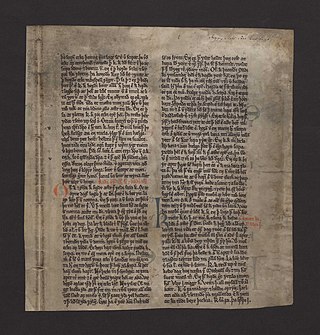
In Nordic mythology, Asgard is a location associated with the gods. It appears in a multitude of Old Norse sagas and mythological texts. It is described as the fortified home of the Æsir gods, often associated with gold imagery. Many of the best-known Nordic gods are Æsir or live in Asgard such as Odin, Thor, Loki, and Baldr.
"Edda" is an Old Norse term that has been applied by modern scholars to the collective of two Medieval Icelandic literary works: what is now known as the Prose Edda and an older collection of poems now known as the Poetic Edda. The term historically referred only to the Prose Edda, but this usage has fallen out of favour because of confusion with the other work. Both works were written down in Iceland during the 13th century in Icelandic, although they contain material from earlier traditional sources, reaching back into the Viking Age. The books provide the main sources for medieval skaldic tradition in Iceland and for Norse mythology.

Heimskringla is the best known of the Old Norse kings' sagas. It was written in Old Norse in Iceland by the poet and historian Snorri Sturluson (1178/79–1241) c. 1230. The name Heimskringla was first used in the 17th century, derived from the first two words of one of the manuscripts.
In Norse mythology, Snotra is a goddess associated with wisdom. Snotra is attested in the Prose Edda, written in the 13th century by Snorri Sturluson, and in the Gautreks Saga, where she is the mother of Gautrek son of Gauti, the eponymous ancestor of the Geats, and Goths, a son of Oðinn as King of Sviþjoð. Scholars have proposed theories about the implications of the goddess.

The Prose Edda, also known as the Younger Edda, Snorri's Edda or, historically, simply as Edda, is an Old Norse textbook written in Iceland during the early 13th century. The work is often considered to have been to some extent written, or at least compiled, by the Icelandic scholar, lawspeaker, and historian Snorri Sturluson c. 1220. It is considered the fullest and most detailed source for modern knowledge of Norse mythology, the body of myths of the North Germanic peoples, and draws from a wide variety of sources, including versions of poems that survive into today in a collection known as the Poetic Edda.
In Norse mythology, Níðhöggr is a dragon who gnaws at a root of the world tree, Yggdrasil. In historical Viking society, níð was a term for a social stigma, implying the loss of honor and the status of a villain. Thus, its name might refer to its role as a horrific monster in its action of chewing the corpses of the inhabitants of Náströnd: those guilty of murder, adultery, and oath-breaking.

Mímir or Mim is a figure in Norse mythology, renowned for his knowledge and wisdom, who is beheaded during the Æsir–Vanir War. Afterward, the god Odin carries around Mímir's head and it recites secret knowledge and counsel to him.

In Norse mythology, Hati Hróðvitnisson is a warg; a wolf that, according to Snorri Sturluson's Prose Edda, chases Máni, the Moon, across the night sky, just as the wolf Sköll chases Sól, the Sun, during the day, until the time of Ragnarök, when they will swallow these heavenly bodies. Snorri also gives another name for a wolf who swallows the Moon, Mánagarmr.
In Norse mythology, Lofn is a goddess. Lofn is attested in the Prose Edda, written in the 13th century by Snorri Sturluson and in kennings found in skaldic poetry. In the Prose Edda, Lofn is described as gentle in manner and as an arranger of marriages, even when they have been forbidden. Scholars have proposed theories about the implications of the goddess.

Old Norse Yngvi, Old High German Ing/Ingwi and Old English Ing are names that relate to a theonym which appears to have been the older name for the god Freyr. Proto-Germanic Ingwaz was the legendary ancestor of the Ingaevones, or more accurately Ingvaeones, and is also the reconstructed name of the Elder Futhark rune ᛜ and Anglo-Saxon rune ᛝ, representing ŋ.
Various gods and men appear as sons of Odin in old Old Norse and Old English texts.
In Norse mythology, Auðr is the son of the personified night, Nótt, fathered by Naglfari, and uncle of Thor. Auðr is attested in the Prose Edda, written in the 13th century by Snorri Sturluson, and in the poetry of skalds.
In Norse mythology, Barri is the place where Freyr and Gerðr are to consummate their union, as stated in the Skírnismál:

In Norse mythology, Himinbjörg is the home of the god Heimdallr. Himinbjörg is attested in the Poetic Edda, compiled from earlier traditional sources, and the Prose Edda and Heimskringla, both written in the 13th century by Snorri Sturluson. Himinbjörg is associated with Heimdallr in all sources. According to the Poetic Edda, Heimdallr dwells there as watchman for the gods and there drinks fine mead, whereas in the Prose Edda Himinbjörg is detailed as located where the burning rainbow bridge Bifröst meets heaven. Scholars have commented on the differences between the two attestations and linked the name of the mythical location to various place names.
In Norse mythology, Sindri is the name of both a dwarf and a hall that will serve as a dwelling place for the souls of the virtuous after the events of Ragnarök. Sindri is also referred to as Eitri, the brother of Brokkr.
Gjöll is the river that separates the living from the dead in Norse mythology. It is one of the eleven rivers traditionally associated with the Élivágar, rivers that existed in Ginnungagap at the beginning of the world.
In Norse mythology, Mótsognir, also found as Móðsognir, "he who drinks in courage", is the ruler of the dwarves. In Völuspà 10, he is identified as mæztr um orðinn dverga allra, "lord of all the dwarves". According to Snorri Sturluson in Gylfaginning 14, which seeks to explain this verse, "the dwarfs had taken shape first and acquired life in the flesh of Ymir and were then maggots, but by decision of the gods they became conscious with intelligence and had the shape of men though they live in the earth and in rocks. Modsognir was a dwarf and the second was Durinn."
In Norse mythology, Þrívaldi, whose name means "thrice mighty", is a jötunn killed by Thor.

Snorri Sturluson was an Icelandic historian, poet, and politician. He was elected twice as lawspeaker of the Icelandic parliament, the Althing. He is commonly thought to have authored or compiled portions of the Prose Edda, which is a major source for what is today known about Norse mythology and alliterative verse, and Heimskringla, a history of the Norse kings that begins with legendary material in Ynglinga saga and moves through to early medieval Scandinavian history. For stylistic and methodological reasons, Snorri is often taken to be the author of Egil's saga. He was assassinated in 1241 by men claiming to be agents of the King of Norway.
Fróði's Peace is a semi-legendary period of peace throughout Northern Europe that is referenced in Nordic mythology, skaldic poetry and historical accounts.









